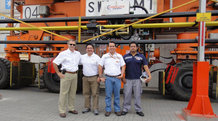First E-RTG conductor rail system in South America now in operation
RTG Electrification
Installation of the plug-in E-RTG system by Conductix-Wampfler successfully completed / savings in diesel consumption of container cranes / next phase of expansion already on the drawing board.
Weil am Rhein, December, 2011. Conductix-Wampfler, the global leading manufacturer of systems for power and data transmission to mobile consumers, has successfully concluded the installation of the first E-RTG conductor rail systems in South America for the electrification of diesel-powered "rubber tired gantry" cranes (RTGs). In the Ecuadorian port city of Guayaquil, which handles about 65 percent of the total container traffic of the country, this German technology is in use as a Plug-In version in a container block 250 meters in length, supplying two RTGs with reliable power.
"The port operator CONTECON Guayaquil SA first became aware of our E-RTG technology at last year's TOC Americas in Buenos Aires," explains Uwe Manthei, Senior Manager Global E-RTG Projects at Conductix-Wampfler. Management was particularly impressed by the potential for energy savings. Diesel-driven RTGs account for up to half of the power consumed in a port, and are thus responsible for a significant part of its CO2 emissions. Using Conductix-Wampfler's E-RTG system, cranes can quickly be converted to cost-saving, environmentally friendly electrical operation. "CONTECON was convinced from the start that the test system would achieve the savings objectives, so they are already planning another environmentally protective expansion of the port," says Christian Nunez, Latin America Business Development Manager at Conductix-Wampfler Americas.
Several E-RTG solutions to choose from
Conductix-Wampfler offers the electrification of RTGs either by motor-driven cable reels or conductor rails, as Drive-In solutions or a Plug-In solution. In the "Plug-In" solution with conductor rails, the RTG is "unplugged" and "plugged back in" when changing container corridors. The conversion to an E-RTG with the newer "Drive-In" systems makes even that manual step unnecessary, since the collector trolleys of the conductor rail system are automatically guided into the guide rails of the steel frame when the RTG crane moves into the corridor.
Conductix-Wampfler has continued to optimize the Drive-in solution since its introduction in 2009. The Drive-in L system currently on the market has an extremely compact design, works entirely without pneumatic or hydraulic components, and is currently the lightest on the market. This means it can be used for any E-RTG, even those with little room for additional components. "We therefore assume that the product can set entirely new benchmarks in the E-RTG electrification market," says Manthei.
In Guayaquil, planning for the future is therefore moving towards the Drive-In solution. "Our Latin America Team and the E-RTG Team are working very closely with CONTECON to develop the ideal system for their needs on-site," says Manthei. CONTECON initially decided on a Plug-In system, but left the option open of moving to the automatic Drive-In solution. The system was therefore designed flexibly from the start.






